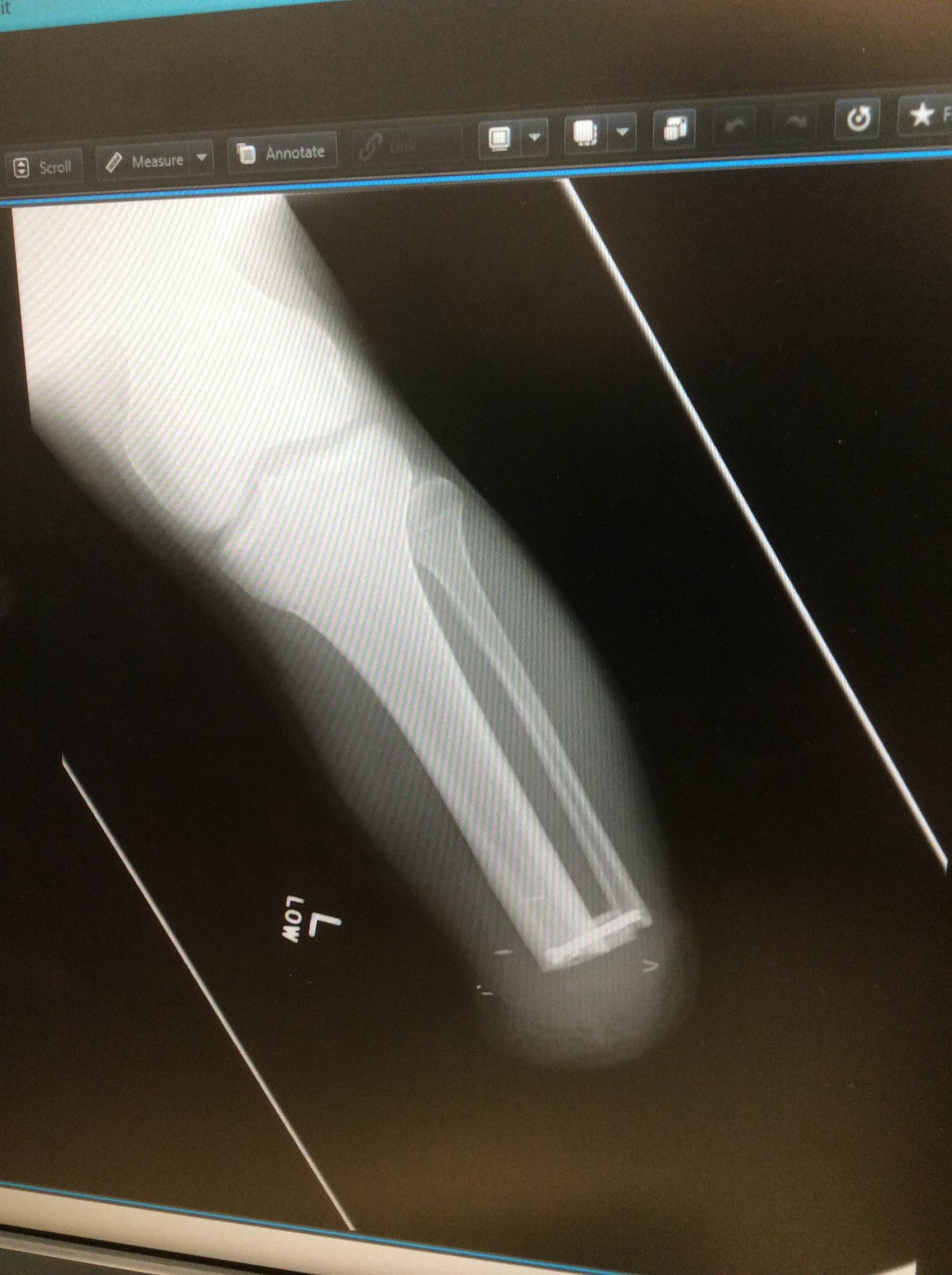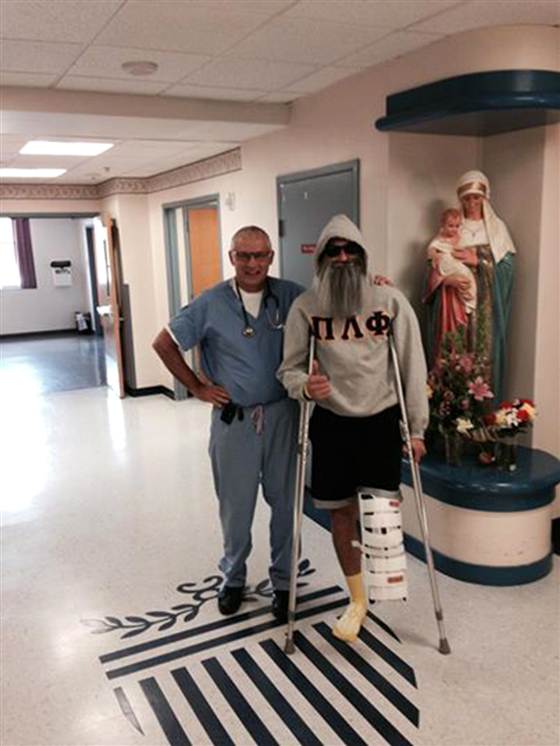Medical Jargon
Before Joe's surgery, I knew NOTHING about prosthetics or amputation. And I mean nothing. I definitely had to learn as we go...I think we all did. It has been a crazy experience that has both taught me an incredible amount not just emotionally, but academically as well. I know more about Ertl amputations, fiberglass sockets and desensitization than I ever thought I would.
As I've been writing these blogs about our experiences, I have realized that perhaps there are some things you might not know too. So today, I'm going to break it down a little bit and explain some different parts about the amputation, the healing, and the prosthetics.
Let's start with the amputation. We went to Dr. Attinger (with Joe above) at Georgetown Hospital.
Dr. Attinger does 200+ amputations a year, and did an amazing job with Joe's leg. Per Joe's request, Dr. A cut open Joe's foot to ensure that this was the right decision for Joey. He even took photos to show use afterwards (he used his iPhone! haha). The images (link below) show the mushiness of the inside of Joe's foot. Dr. A didn't even know how Joey was walking at the point of amputation because it was so bad.
Beware, these images are bloody and not for the faint of heart (which is why they are on a separate page and not directly on the blog.)
So I was going to put some graphics together to show you how it works, and I even googled 'BTK (below the knee) Amputation Graphics, and that was a really bad idea. Gross.
Anyways, I will try to explain what happens. Please keep in mind that I am in NO WAY a doctor. This is just my personal experience with Joe and his surgery. I may not entirely have everything 100% correct, but this is how I have seen and understood everything. When the leg is cut off, the surgeon cuts about 90% of it off, but leaves the back of the calf skin, muscles and nerves long enough to wrap it around the bottom of the stump. These pieces are then reattached and stitched to the front of the leg, where they will eventually reform together and the stitches will dissolve.
THE SURGERY
This is where Joe's surgery comes in. The nerves they wrap around in some cases can pop back up to the surface. In Joe's case, this has happened and is causing him to have a pressure point towards the bottom left of his stump. It not only sends real pain up his stump, but also sets off the phantom pain. This has made it harder to find liners and sockets that work well without hitting this pressure point. The upcoming surgery will remove a major nerve and 2 minor nerves that cause this pain. It's about a month recovery (so a month on crutches). So as you can probably see, as much as we don't want to have another surgery, it's going to help out A LOT in Joe's comfort for the future.
This is an image of Joey's stump from right after Joe's surgery and we were still in the hospital. A stump is what they call what's left of the leg without a foot. The arrow shows how they wrap the skin, nerves and muscle around.
ERTL AMPUTATION
For stability, they also take part of the bone from the part of the leg that's cut off and screw it in between the tibia and fibula so they don't flap back and fort in different direction. This is called an Ertl Amputation. Eventually, the bone will grow around the screw and the Ertl so it almost becomes like one big, horse shoe of a bone.Here's an x-ray of what it looks like.
ATROPHY
Here's Joey about a month or so after the surgery back at Dr. A's for a check-up. As you can see, his stump has gotten significantly smaller in that month. This is called 'atrophy.' Atrophy technically means that it declines in effectiveness due to underuse. Think about your calf and how much muscle you have. When you cut that and reform it in an amputation, your calf muscle as it was is no longer necessary and it basically decrease in size until you pretty much have very little muscle left (comparatively). It can take up to a year to fully stabilize your muscles.
The hardest part about atrophy, is when you start wearing prosthetics.
During the time between the surgery and your first prosthetic, they ask you to do some desensitization. This is introducing your fresh stump to differing fabrics or different feeling textures to get it more accustomed to it's new form. According to Joe at first, some things were very weird feeling. But in the end, it definitely helped when it came time to get his prosthetic.
PROSTHETICS
Getting a prosthetic is both exciting, and painful. It's exciting to be walking again and get back something that you took completely for granted before, but imagine putting a fairly fresh stump into a new liner and socket and then putting weight on it to walk. It takes a while to adjust and get used to.
I'm going to start by explaining what some of the prosthetic jargon is.
So, essentially: the stump goes in the liner that goes into the socket that's attached to the foot. The liner is what you put on the stump that holds suction to the socket and foot (see image #1 below). There are many different types of liners depending upon what works for each person. The foot is attached to the socket by titanium hardware. There are TONS of different types of feet for every day use and specialty sports.
Joe has both an everyday leg and a running blade. When Joe got his first prosthetic, we went through a TON of test sockets. His stump changed a lot. When the stump has minor changes during the day, you can add or take away a sock from the liner. Socks are just like regular socks, but shaped for a stump and add extra cushion/padding to the liner if your stump shrinks too much for the liner.
This happens especially when Joe's physically active.
 This is a progression of how a socket is made.
This is a progression of how a socket is made.
1. You put the liner on.
2. This is Elliott. He's Joe's Prosthetist (or leg guy!). He's pretty awesome and totally understands Joe and his needs with this new leg. He places plastic wrap over it the liner, and makes notes according to Joe's stump size and bone structures.
3. He covers it with plaster of paris to make a mold (yes, just like an art project). Then they make a socket from this mold.
The socket is either plastic or fiberglass part that holds the stump and liner. Plastic sockets are used as test sockets when the stump is still shrinking from atrophy. Fiberglass is considered a permanent socket when the stump has stabilized. So, I realize that isn't necessarily FUN, but it might explain a little bit more about how it all happens and what goes into an amputation.
Here's Joe running his blade.
I know over the past year as I see people, they have a TON questions. And I am more than happy to answer them. So between now and next week, if you have a question about amputation or our experience, I would love to hear it! Joe did a Reddit AMA (Ask me Anything) over the summer and had all kinds of crazy questions, so nothing is off limits. You can comment here, Facebook or shoot me an email at johnna@twilaco.com






